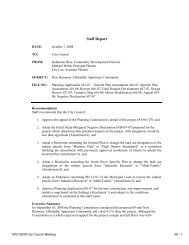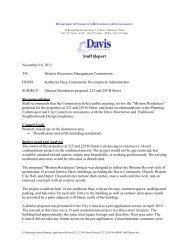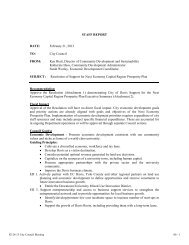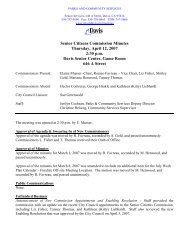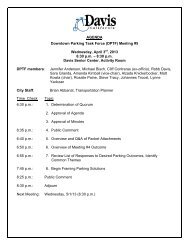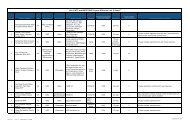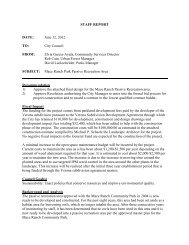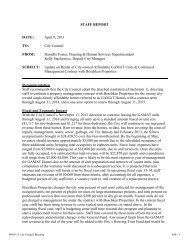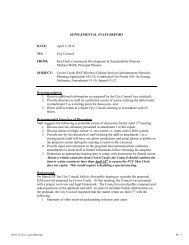10 Draft Integrated Waste Management Plan - City Council - City of ...
10 Draft Integrated Waste Management Plan - City Council - City of ...
10 Draft Integrated Waste Management Plan - City Council - City of ...
You also want an ePaper? Increase the reach of your titles
YUMPU automatically turns print PDFs into web optimized ePapers that Google loves.
2012 Davis <strong>Integrated</strong> <strong>Waste</strong> <strong>Management</strong> <strong>Plan</strong><br />
5.5.3.1 Expansion <strong>of</strong> Materials Accepted in Recycling Carts<br />
As listed above, there are several types <strong>of</strong> materials that are not accepted for recycling in the recycling carts.<br />
Items that currently have recycling markets are discussed below.<br />
Electronics are not recommended for collection in recycling carts as they can be damaged in collection and<br />
transport, releasing hazardous chemicals. Electronics are best suited for drop-<strong>of</strong>f recycling program, not<br />
automated collection in recycling carts. Electronics will be discussed in further detail in section <strong>10</strong>.2.2.<br />
Plastic bags and other clean plastic film could potentially be collected for recycling, but when co-mingled with<br />
other recyclables, the plastic film is easily contaminated by liquid wastes during collection, giving the material a<br />
very low recycling value. Contaminated plastic film does not have a stable recycling market.<br />
Expanded polystyrene (EPS) does have a recycling market, although not a very reliable or pr<strong>of</strong>itable one.<br />
Collecting EPS curbside is not a viable option as the material gets dirty when mixes with other recyclables and<br />
renders it unacceptable for most recycling markets.<br />
Cartons, such as milk cartons and juice boxes do have a recycling market available. Refrigerated cartons, such<br />
as milk cartons, are mostly paper, with layers <strong>of</strong> plastic on the inside and outside. Shelf-stable cartons, such as<br />
juice boxes, are paper cartons lined with plastic, with a layer <strong>of</strong> aluminum and another layer <strong>of</strong> plastic on the<br />
inside. The Carton <strong>Council</strong>, a group <strong>of</strong> carton manufacturers that assist in setting up recycling markets and<br />
systems for cartons, has expressed interest in setting up a market in the Sacramento area. The Carton <strong>Council</strong><br />
estimates that cartons make up 0.5% <strong>of</strong> the residential waste stream. The 2008 CIWMB <strong>Waste</strong> Characterization<br />
Study listed cartons under “All Other Remainder/Composite Paper” which makes up 4.5% <strong>of</strong> the total waste<br />
stream:<br />
All Other Remainder/Composite Paper means items made mostly <strong>of</strong> paper but combined with large amounts <strong>of</strong><br />
other materials such as wax, plastic, glues, foil, food, and moisture, that also are not packaging for items other<br />
than food. Examples include some waxed or plastic-impregnated corrugated cardboard (common for packaging<br />
produce or seafood), aseptic packages, plastic-coated paper milk cartons, waxed paper, tissue, paper towels,<br />
blueprints, sepia, onion skin, fast food wrappers, carbon paper, self adhesive notes, and photographs.<br />
DRAFT<br />
It may be possible to upgrade the sorting system at the DWR sorting facility to add another sorting station so<br />
that another material can be pulled <strong>of</strong>f the sorting line and separated for recycling. However, cartons exist in<br />
such small amounts in the waste stream as to make collection cost prohibitive, especially due to the small size<br />
<strong>of</strong> Davis. Larger jurisdictions may be able to service a large enough area and collect enough material to make<br />
collection pr<strong>of</strong>itable. A drop-<strong>of</strong>f recycling program may be a better option for these materials.<br />
5.5.3.2 Expansion <strong>of</strong> Materials Accepted for Drop-<strong>of</strong>f Recycling<br />
Another way to expand the materials that are recyclable is to <strong>of</strong>fer drop-<strong>of</strong>f recycling at the DWR recycling<br />
center. This way, the recyclables are pre-sorted and must only be allocated a space to collect them and time to<br />
process and bale them before sale. If local markets existed for the following items, this may be the simplest and<br />
economical way to collect and recycle these items:<br />
Cartons (milk, juice, etc.)<br />
Electronics (will be discussed further in section <strong>10</strong>.2.2)<br />
Page | 5-31



